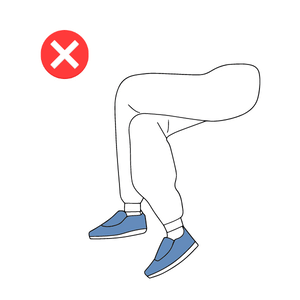
Many people have a question that how to sleep with sciatica. Sciatica is a common condition that affects many people, causing pain, tingling, and numbness in the lower back and legs. This pain can make it difficult to get a good night’s sleep, which can further exacerbate the condition. Fortunately, there are a number of steps that people with sciatica can take to help improve their sleep and manage their pain. In this article, we will explore some of the best sleep positions, exercises, and other strategies for managing sciatica and getting the rest you need to feel your best.
How to Sleep With Sciatica?
Sleeping with sciatica can be a difficult task, but by following these 16 tips, you can find relief from the pain and discomfort of this condition:
1. Use a supportive mattress:
A supportive mattress can help reduce pressure on your lower back and legs and provide comfort to help you sleep better. Consider using a medium-firm mattress or a memory foam mattress, as they are often recommended for people with back pain.

2. Experiment with pillows:
Experimenting with different types of pillows can help you find the most comfortable and supportive sleep position. Consider using a pillow to support your legs or a lumbar roll to support your lower back.
3. Sleep on your side:
Sleeping on your side with a pillow between your knees can help reduce the pressure on your lower back and legs, making it a good option for those with sciatica.

4. Use a body pillow:
A full-body pillow can help provide support for your back, hips, and legs, helping to reduce pressure and alleviate pain.

5. Avoid sleeping on your stomach:
Sleeping on your stomach can put extra pressure on your lower back and legs, making it a less ideal sleep position for those with sciatica.

6. Try a heating pad:
Using a heating pad before bed can help to relax your muscles and relieve pain. Consider using a heating pad or a hot water bottle to help warm up your muscles before bed.
7. Stretch before bed:
Gentle stretching exercises can help to loosen up your muscles and relieve pain before bed. Consider stretching your legs, hips, and lower back before bed to help reduce pain and improve sleep.
8. Practice good posture:
Good posture can help reduce pressure on your lower back and legs, reducing pain and discomfort. Consider sitting and standing with good posture to help reduce pain and improve sleep.
9. Use a supportive chair:
A supportive chair can help reduce pressure on your lower back and legs, making it easier for you to sit and work for longer periods of time. Consider using a chair with good lumbar support to help reduce pain and improve sleep.
10. Exercise regularly:
Regular exercise can help to improve circulation, relieve pain, and reduce the risk of sciatica. Consider doing regular low-impact exercises such as walking, swimming, or yoga to help reduce pain and improve sleep.
11. Maintain a healthy weight:
Maintaining a healthy weight can help reduce the pressure on your lower back and legs, reducing pain and improving sleep. Consider eating a healthy, balanced diet to help maintain a healthy weight and reduce pain.
12. Manage stress:
Stress can increase pain and make it more difficult to sleep. Consider using relaxation techniques such as meditation or deep breathing to help reduce stress and improve sleep.
13. Use over-the-counter pain relievers:
Over-the-counter pain relievers such as ibuprofen or acetaminophen can help relieve pain and improve sleep. Consult with your doctor before taking any new medications.
14. Seek medical treatment:
If your sciatica symptoms are severe, consider seeking medical treatment. Your doctor may recommend physical therapy, medication, or other treatments to help relieve pain and improve sleep.
15. Keep a sleep diary:
Keeping a sleep diary can help you track your sleep patterns and identify any changes that may be impacting your sleep. Consider recording your bedtime and wake-up time, how you feel when you wake up, and any symptoms you experience throughout the day.
16. Create a sleep-conducive environment:
A sleep-conducive environment can help you get the rest you need to feel your best. Consider creating a dark, quiet, and cool environment in your bedroom to help improve sleep. Turn off electronics, use a white noise machine, and keep the room at a temperature between 60-67°F to create an optimal sleep environment.
In conclusion, by following these tips and making lifestyle changes, you can improve your sleep quality and reduce the pain and discomfort associated with sciatica. It’s important to remember that everyone is different and what works for one person may not work for another, so be patient and persistent in your efforts to find what works best for you. If you have persistent or worsening symptoms, consult your doctor for further evaluation and treatment.
How to sleep with sciatica pain during pregnancy?
Sciatica pain during pregnancy can be uncomfortable and interfere with sleep. However, there are several strategies you can try to alleviate pain and improve your sleep quality. Here are some tips for sleeping with sciatica pain during pregnancy:
1. Sleep on your side:
Sleeping on your side, particularly on your left side, can help reduce pressure on the sciatic nerve and alleviate pain. You can place a pillow between your legs to help keep your hips and spine in alignment.

2. Use a maternity pillow:
A maternity pillow can help support your growing belly, back, and hips while you sleep, reducing pressure on the sciatic nerve and alleviating pain.

3. Avoid sleeping on your back:
Sleeping on your back can increase pressure on your lower back and legs, worsening pain and discomfort. Try to avoid sleeping in this position and instead opt for sleeping on your side.
4. Practice good sleep hygiene:
Good sleep hygiene, such as avoiding caffeine, electronics, and napping in the late afternoon or evening, can help improve sleep quality and reduce pain and discomfort associated with sciatica.
5. Perform stretching exercises:
Before bed, perform stretching exercises to help reduce muscle tension and alleviate pain. Gentle stretching and yoga can be especially helpful for pregnant women.
6. Consult your doctor:
If you have persistent or worsening symptoms, consult your doctor for further evaluation and treatment. Your doctor may be able to recommend additional strategies for managing sciatica pain during pregnancy.
In conclusion, by following these tips and making lifestyle changes, you can improve your sleep quality and reduce the pain and discomfort associated with sciatica during pregnancy. It’s important to listen to your body and be patient in your efforts to find what works best for you. If you have persistent or worsening symptoms, consult your doctor for further evaluation and treatment.
Best sitting position for sciatica
Sitting for prolonged periods can put extra pressure on the sciatic nerve, worsening the pain and discomfort associated with sciatica. Therefore, it’s important to find a sitting position that helps alleviate pressure and reduce pain.
Here are some tips for the best sitting position for sciatica:
1. Use a supportive chair:
Choose a chair with good lumbar support that helps keep your lower back in a neutral position and reduces pressure on the sciatic nerve. You can also use a lumbar roll or cushion to support your lower back.
2. Keep your feet flat on the floor:
Keeping your feet flat on the floor helps distribute your weight evenly, reducing the pressure on your lower back and legs.

3. Adjust the height of your chair:
The height of your chair should allow you to keep your feet flat on the floor and your hips level with or slightly higher than your knees. This helps reduce pressure on your lower back and legs.
4. Maintain good posture:
Good posture helps keep your spine in a neutral position, reducing pressure on the sciatic nerve. Sit up straight, keep your shoulders back, and avoid slouching or hunching over.
5. Take frequent breaks:
Sitting for prolonged periods can increase pressure on the sciatic nerve and worsen the pain. Take frequent breaks to stretch and move around to help reduce pressure and alleviate pain.
6. Use a standing desk:
If possible, consider using a standing desk or using a combination of standing and sitting to reduce the amount of time you spend sitting.
7. Avoid crossing your legs:
Crossing your legs can put extra pressure on your lower back and legs, making it a less ideal sitting position for those with sciatica. Keep your feet flat on the floor and avoid crossing your legs.

8. Avoid leaning forward:
Leaning forward can increase pressure on your lower back and legs, worsening pain and discomfort. Sit up straight and maintain a good posture to reduce pressure on the sciatic nerve.
By following these tips, you can find a sitting position that helps reduce pressure and alleviate pain associated with sciatica. Remember, everyone is different and what works for one person may not work for another. If you have persistent or worsening symptoms, consult your doctor for further evaluation and treatment.
In conclusion, by taking the time to find a supportive and comfortable sitting position, you can help reduce the pain and discomfort associated with sciatica and improve your overall quality of life. By following these tips and making lifestyle changes, you can find the relief you need and get back to your daily activities.






